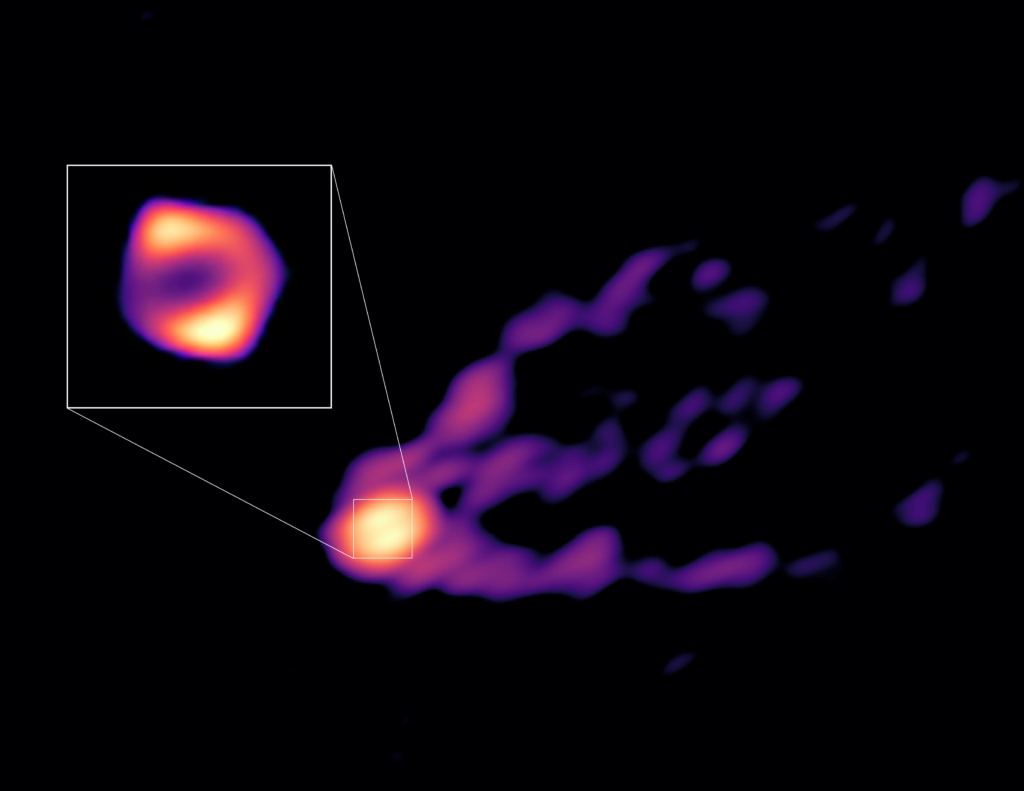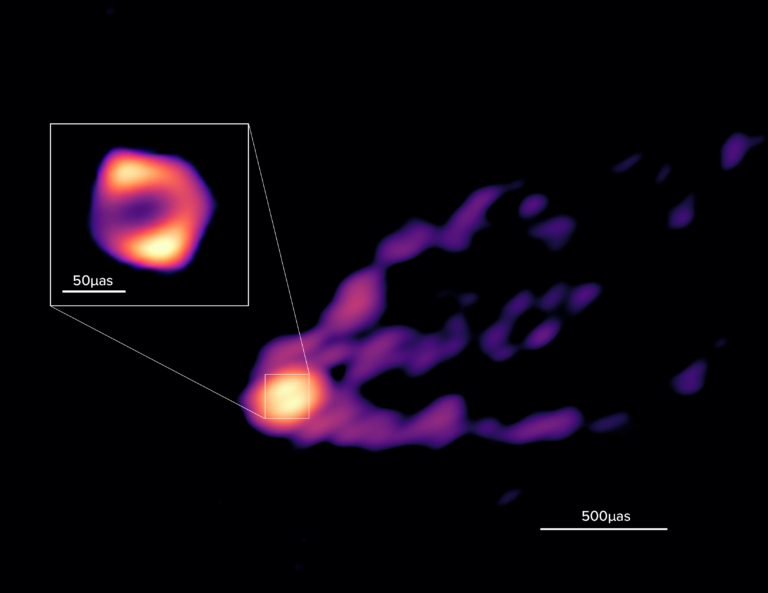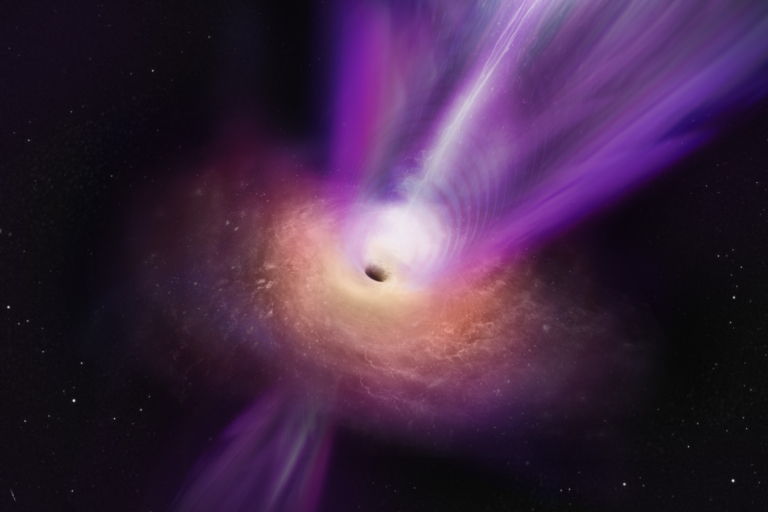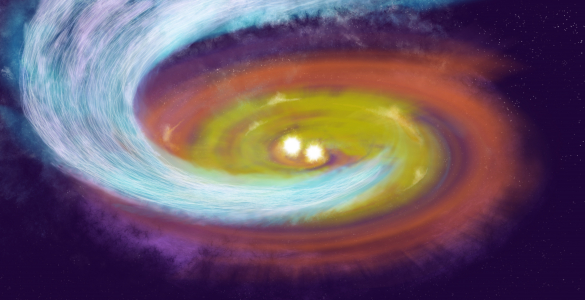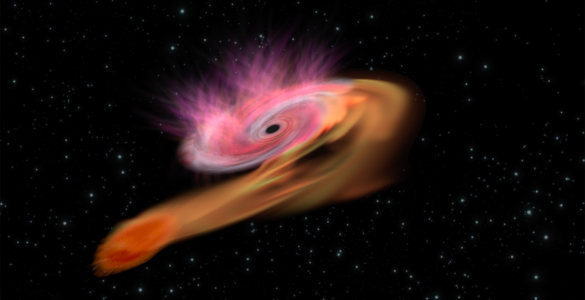Scientists studying the supermassive black hole at the heart of the M87 galaxy have revealed the origins of the monster’s powerful jet and imaged the jet and its source together for the first time. What’s more, the observations have revealed that the black hole’s ring is much larger than scientists previously believed. The observations published today in Nature.
The Global mm-VLBI Array (GMVA) united radio telescopes around the world to produce these new results, including the National Science Foundation’s National Radio Astronomy Observatory (NRAO) and Green Bank Observatory (GBO), Atacama Large Millimeter/submillimeter Array (ALMA), Very Long Baseline Array (VLBA), and Green Bank Telescope (GBT).
The SMBH at the center of the M87 galaxy is the most recognizable in the Universe. It was the first black hole to be captured in an image, created by the Event Horizon Telescope (EHT) and made public in 2019. The image of its dense, dark core framed by an amorphous glowing ring made international headlines.
“M87 has been observed over many decades, and 100 years ago we knew the jet was there, but we couldn’t place it in context,” said Ru-Sen Lu, an astronomer at the Shanghai Astronomical Observatory, leader of a Max Planck Research Group at the Chinese Academy of Sciences, and lead author of the new paper. “With GMVA, including the premier instruments at NRAO and GBO, we’re observing at a lower frequency so we’re seeing more detail— and now we know there are more details to see.”
Eduardo Ros, an astronomer and the Scientific Coordinator for Very Long Baseline Interferometry (VLBI) at the Max Planck Institute for Radio Astronomy added, “We’ve seen the ring before, but now we see the jet. This puts the ring in context— and it’s bigger than we thought. If you think of it like a fire-breathing monster, before, we could see the dragon and the fire, but now we can see the dragon breathing the fire.”
Using many different telescopes and instruments gave the team a more complete view of the structure of the supermassive black hole and its jet than was previously possible with EHT, and all of the telescopes were required to paint a full picture. While VLBA provided a full view of both the jet and the black hole, ALMA allowed the scientists to resolve M87’s bright radio core, and create a sharp picture. The sensitivity of the GBT’s 100-meter collecting surface enabled astronomers to resolve both the large and small-scale parts of the ring and see the finer details.
“The original EHT imaging revealed only a portion of the accretion disk surrounding the center of the black hole. By changing the observing wavelengths from 1.3 millimeters to 3.5 millimeters, we can see more of the accretion disk, and now the jet, at the same time. This revealed that the ring around the black hole is 50 percent larger than we previously believed,” said scientist Toney Minter, GMVA coordinator for the GBT.
Not only are the parts of the black hole bigger than shorter wavelength observations previously revealed, but it is now possible to confirm the origin of the jet. This jet was born from the energy created by the magnetic fields surrounding the spinning core of the black hole and winds rising up from the black hole’s accretion disk.
“These results showed—for the first time—where the jet is being formed. Prior to this, there were two theories about where they might come from,” said Minter. “But this observation actually showed that the energy from the magnetic fields and the winds are working together.”
Harshal Gupta, NSF Program Officer for the Green Bank Observatory, added, “This discovery is a powerful demonstration of how telescopes possessing complementary capabilities can be used to fundamentally advance our understanding of astronomical objects and phenomena. It is exciting to see the different types of radio telescopes supported by NSF work synergistically as important elements of the GMVA to enable the big picture view of M87’s black hole and jet.”
The Green Bank Observatory and the National Radio Astronomy Observatory are major facilities of the National Science Foundation, operated under cooperative agreement by Associated Universities, Inc.
About ALMA
ALMA construction and operations are led by ESO on behalf of its Member States; by the National Radio Astronomy Observatory (NRAO), managed by Associated Universities, Inc. (AUI), on behalf of North America; and by the National Astronomical Observatory of Japan (NAOJ) on behalf of East Asia. The Joint ALMA Observatory (JAO) provides the unified leadership and management of the construction, commissioning and operation of ALMA.






